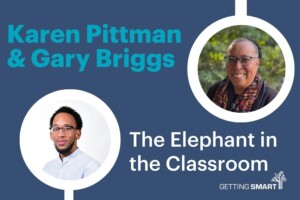Touching the education elephant
 You know the old story of the blind men and the elephant. I had one of those weeks where I was able to hopscotch between 10 groups trying to figure out what they were experiencing. They included:
You know the old story of the blind men and the elephant. I had one of those weeks where I was able to hopscotch between 10 groups trying to figure out what they were experiencing. They included:
- A high school staff seeking to boost engagement and achievement
- A high school thinking about a new building
- Business leaders and legislators contemplating cuts and opportunities
- Venture investors considering new edtech deals
- Legislators at an online learning summit
- Folks expanding learning options in rural high school education
- Lots of calls with companies trying to revolutionize assessment
- Lunch with edreformers (and ensuing twitter argument)
- Responding to a thoughtful white paper on what stuff should cost
- Adding some missing background on an EMO report
It’s hard to know what this all means just yet. But it’s clear that this is a decade of new challenges. States and schools are grappling with new higher standards during the decade of deficits (as Marguerite Roza called it this week). Both are unfamiliar territory. Budget cuts make it tough to consider new expectations but force system heads to think differently.
It’s also a decade of new opportunities. There more models and more tools than ever. K-12 is becoming far more dynamic with more talent and more investment coming into the sector. We’re living through a phase change at least as significant as the printing press and it’s exciting but confusing.
As you can tell from the list, I’m intentionally casting a wide net, but it’s all focused on innovations in learning. Blogging helps me make sense of what I’m experiencing.
What’s your personal learning plan? How are you making sure you get multiple touches at the education elephant? How are you making sense of it all?






Paul Hoss
Good post, Tom.
Funny you should ask. I just released my personal learning plan in a new book, Common Sense: The Missing Link in Education Reform.
All kids are different. They show up on the first day of school with different strengths and weaknesses as well as varied levels of readiness and motivation. The book focuses on how the personal learning rate/pace of every student in the class is different in each subject and how these differences can be addressed. It chronicles the variables involved in allowing this to happen so each student can progress at their own pace.
Today, some of this, of course, can now be enhanced by technology but the teacher can also make all this possible with a variety of conventional practices as well.
It's an additional workload getting this model established, but once in place no more work (really) than a traditional model.
This model was motivated by all the time I spent in school as a student, bored. It also works great for kids who simply need more time to learn a new concept or lesson. In this classroom, no child should be bored and none should be overwhelmed. The pace of learning should be just right for each youngster.
Jean Tower
It was very interesting to see you compare your learning network to the parable about the blind man and the elephant. I used that very comparison a couple of years ago, Seeing the Whole Elephant, at http://k12edubuzz.com/seeing-the-whole-elephant/. And definitely, I think we all have to build our learning networks so that they include a diversity of voices and perspectives.
Replies
Tom Vander Ark
Thanks for the link, great blog.
I'm struck every week by how complicated and dynamic education is in the US. It's really hard to have anything but superficial knowledge of issues across the states much less the 15,000 districts. Building a strong & informative personal learning network is a great suggestions. Thanks!